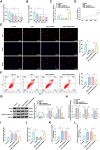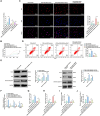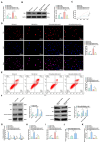Long non-coding RNA Small Nucleolar RNA Host Gene 4 ameliorates cigarette smoke-induced proliferation, apoptosis, inflammation, and airway remodeling in alveolar epithelial cells through the modulation of the mitogen-activated protein kinase signaling pathway via the microRNA-409-3p/Four and a Half LIM Domains 1 axis
- PMID: 38831471
- PMCID: PMC11149209
- DOI: 10.1186/s40001-024-01872-x
Long non-coding RNA Small Nucleolar RNA Host Gene 4 ameliorates cigarette smoke-induced proliferation, apoptosis, inflammation, and airway remodeling in alveolar epithelial cells through the modulation of the mitogen-activated protein kinase signaling pathway via the microRNA-409-3p/Four and a Half LIM Domains 1 axis
Abstract
The long non-coding RNA (lncRNA) Small Nucleolar RNA Host Gene 4 (SNHG4) has been demonstrated to be significantly downregulated in various inflammatory conditions, yet its role in chronic obstructive pulmonary disease (COPD) remains elusive. This study aims to elucidate the biological function of SNHG4 in COPD and to unveil its potential molecular targets. Our findings reveal that both SNHG4 and Four and a Half LIM Domains 1 (FHL1) were markedly downregulated in COPD, whereas microRNA-409-3p (miR-409-3p) was upregulated. Importantly, SNHG4 exhibited a negative correlation with inflammatory markers in patients with COPD, but a positive correlation with forced expiratory volume in 1s percentage (FEV1%). SNHG4 distinguished COPD patients from non-smokers with high sensitivity, specificity, and accuracy. Overexpression of SNHG4 ameliorated cigarette smoke extract (CSE)-mediated inflammation, apoptosis, oxidative stress, and airway remodeling in 16HBE bronchial epithelial cells. These beneficial effects of SNHG4 overexpression were reversed by the overexpression of miR-409-3p or the silencing of FHL1. Mechanistically, SNHG4 competitively bound to miR-409-3p, mediating the expression of FHL1, and consequently improving inflammation, apoptosis, oxidative stress, and airway remodeling in 16HBE cells. Additionally, SNHG4 regulated the miR-409-3p/FHL1 axis to inhibit the activation of the mitogen-activated protein kinase (MAPK) pathway induced by CSE. In a murine model of COPD, knockdown of SNHG4 exacerbated CSE-induced pulmonary inflammation, apoptosis, and oxidative stress. In summary, our data affirm that SNHG4 mitigates pulmonary inflammation, apoptosis, and oxidative damage mediated by COPD through the regulation of the miR-409-3p/FHL1 axis.
Keywords: COPD; FHL1; Lnc SNHG4; MAPK; miR-409-3p.
© 2024. The Author(s).
Conflict of interest statement
Authors declared no conflict of interest.
Figures








Similar articles
-
Long non-coding RNA SNHG4 aggravates cigarette smoke-induced COPD by regulating miR-144-3p/EZH2 axis.BMC Pulm Med. 2023 Dec 19;23(1):513. doi: 10.1186/s12890-023-02818-5. BMC Pulm Med. 2023. PMID: 38114929 Free PMC article.
-
Expression of long non-coding RNA LUCAT1 in patients with chronic obstructive pulmonary disease and its potential functions in regulating cigarette smoke extract-induced 16HBE cell proliferation and apoptosis.J Clin Lab Anal. 2021 Jul;35(7):e23823. doi: 10.1002/jcla.23823. Epub 2021 Jun 14. J Clin Lab Anal. 2021. PMID: 34125980 Free PMC article.
-
Overexpression Of hsa-miR-664a-3p Is Associated With Cigarette Smoke-Induced Chronic Obstructive Pulmonary Disease Via Targeting FHL1.Int J Chron Obstruct Pulmon Dis. 2019 Oct 9;14:2319-2329. doi: 10.2147/COPD.S224763. eCollection 2019. Int J Chron Obstruct Pulmon Dis. 2019. PMID: 31632001 Free PMC article.
-
Long Noncoding Transcriptome in Chronic Obstructive Pulmonary Disease.Am J Respir Cell Mol Biol. 2019 Dec;61(6):678-688. doi: 10.1165/rcmb.2019-0184TR. Am J Respir Cell Mol Biol. 2019. PMID: 31486667 Free PMC article. Review.
-
Non-Coding RNA Related to MAPK Signaling Pathway in Liver Cancer.Int J Mol Sci. 2022 Oct 7;23(19):11908. doi: 10.3390/ijms231911908. Int J Mol Sci. 2022. PMID: 36233210 Free PMC article. Review.
Cited by
-
Emerging trends and hotspots in chronic obstructive pulmonary disease and oxidative stress: a bibliometric and visualized analysis from 2010 to 2024.J Thorac Dis. 2025 Mar 31;17(3):1228-1248. doi: 10.21037/jtd-24-1679. Epub 2025 Mar 26. J Thorac Dis. 2025. PMID: 40223997 Free PMC article.
-
Role of four and a half LIM domain protein 1 in tumors (Review).Oncol Lett. 2024 Oct 29;29(1):37. doi: 10.3892/ol.2024.14783. eCollection 2025 Jan. Oncol Lett. 2024. PMID: 39512507 Free PMC article. Review.
References
MeSH terms
Substances
LinkOut - more resources
Full Text Sources
Medical
Research Materials

